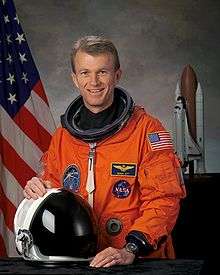Brent W. Jett Jr.
| Brent W. Jett Jr. | |
|---|---|
 | |
| NASA astronaut | |
| Nationality | American |
| Status | Retired |
| Born |
October 5, 1958 Pontiac, Michigan, U.S. |
Other names | Brent Ward Jett Jr. |
Other occupation | Naval aviator, test pilot |
|
USNA, B.S. 1981 NPS, M.S. 1989 | |
| Rank | Captain, USN |
Time in space | 41d 18h 01m |
| Selection | 1992 NASA Group 14 |
| Missions | STS-72, STS-81, STS-97, STS-115 |
Mission insignia |
|
| Retirement | January 2013 |
| Awards |
|
Brent Ward Jett Jr. (born October 5, 1958), (Capt, USN, Ret.), is a retired American naval officer and aviator, test pilot, aerospace and aeronautical engineer, and NASA astronaut.
Personal data
Jett was born in Pontiac, Michigan, but considers Fort Lauderdale, Florida, to be his hometown. Married to Janet Leigh Lyon of Patuxent River, Maryland. His hobbies are water and snow skiing, board sailing, boating, running, basketball, and squash.[1]
Education
He received a Bachelor of Science degree in Aerospace Engineering from the United States Naval Academy in 1981. He received a Master of Science degree in Aeronautical Engineering from the U.S. Naval Postgraduate School in 1989.[2]
Naval service
Jett was designated a Naval Aviator in March 1983, and reported to VF-101 at Naval Air Station Oceana, Virginia for initial F-14 Tomcat training. Upon completion of this training, he was assigned to VF-74 and made overseas deployments to the Mediterranean Sea and Indian Ocean aboard the aircraft carrier USS Saratoga. While assigned to VF-74, he was designated as an airwing qualified Landing Signal Officer (LSO) and also attended the Navy Fighter Weapons School (TOPGUN).[3]
Jett was selected for the U.S. Naval Postgraduate School – Test Pilot School Cooperative Education Program in July 1986, and completed 15 months of graduate work at Monterey, California, before attending the U.S. Naval Test Pilot School in June 1989. After graduation in June 1990, he worked as a project test pilot at the Carrier Stability Department of the Strike Aircraft Test Directorate, Naval Air Test Center, flying the F-14A/B/D, T-45A, and A-7E. Jett returned to the operational Navy in September 1991 and was again assigned to VF-74, flying the F-14B aboard USS Saratoga.
He has logged over 5,000 flight hours in more than 30 different aircraft and has over 450 carrier landings.
NASA career
Selected by NASA in March 1992, Jett reported to the Johnson Space Center in August 1992. After two years of various technical assignments in the Astronaut Office, Jett was assigned to his first mission as the pilot of STS-72. A year later he again served as Pilot on STS-81. From June 1997 to February 1998, he served as NASA Director of Operations at the Yuri Gagarin Cosmonaut Training Center, Star City, Russia. Two years later he was the Commander on STS-97. Finally, he served as the Commander of Space Shuttle Atlantis on STS-115. A veteran of four space missions, he has traveled over 12.1 million miles, and logged a total of 41 days, 18 hours, and 1 minute in space. Jett retired from the U.S. Navy in July 2007, but remained with NASA. In November 2007, he was appointed as Director of Flight Crew Operations. From November 2007 to February 2011, he was Director of Flight Crew Operations at JSC. From March 2010 to January 2013, Jett was the Deputy Manager for the NASA Commercial Crew Program. He retired from NASA in January 2013.
Spaceflight experience
STS-72: Endeavour (January 11–20, 1996) was a 9-day flight during which the crew retrieved the Space Flyer Unit (launched from Japan 10-months earlier), deployed and retrieved the OAST-Flyer, and conducted two spacewalks to demonstrate and evaluate techniques to be used in the assembly of the International Space Station.
STS-81: Atlantis (January 12–22, 1997) was the fifth in a series of joint missions between the U.S. Space Shuttle and the Russian Space Station Mir and the second one involving an exchange of U.S. astronauts. In five days of docked operations more than three tons of food, water, experiment equipment and samples were moved back and forth between the two spacecraft.
STS-97: Endeavour (November 30 to December 11, 2000) was the fifth American mission to build and enhance the capabilities of the International Space Station. STS-97 delivered the first set of U.S.-provided solar arrays and batteries as well as radiators to provide cooling. Three spacewalks were conducted to complete assembly operations while the arrays were attached and unfurled. A communications system for voice and telemetry was also installed.
STS-115: Atlantis (September 9–21, 2006) was the first assembly mission to the International Space Station after the Columbia disaster. STS-115 delivered a new truss segment, including solar panels, to the station.[4]
Organizations
- Society of Experimental Test Pilots
- Association of Naval Aviation
- U.S. Naval Academy Alumni Association
- Association of Space Explorers
Special honors
- Graduated first of 976 in the Class of 1981 at U.S. Naval Academy
- Distinguished Graduate U.S. Naval Test Pilot School Class 95
- Awarded the Distinguished Flying Cross
- Awarded the Defense Meritorious Service Medal and Defense Superior Service Medals
- Awarded the Navy Commendation Medal
- Awarded the NASA Exceptional Service Medal
- Awarded 3 NASA Space Flight Medals
- Awarded the various other service awards
- A portion of Northeast 56th Street in Jett's home city of Fort Lauderdale, Florida, has been designated "Brent Jett Boulevard" in his honor.
References
External links
| Wikimedia Commons has media related to Brent W. Jett, Jr.. |
- Jett's official NASA biography
- Astronautix biography of Brent W. Jett Jr.
- Spacefacts biography of Brent W. Jett Jr.
- Jett at Spaceacts
